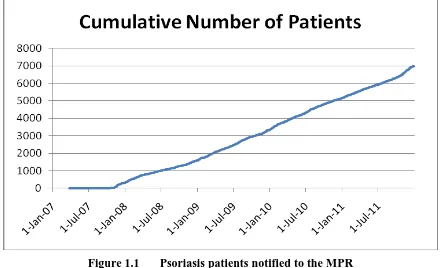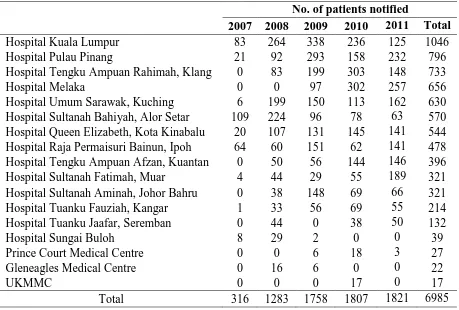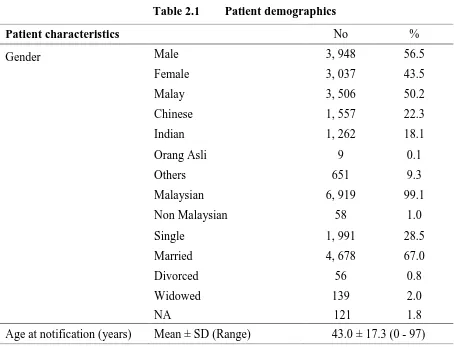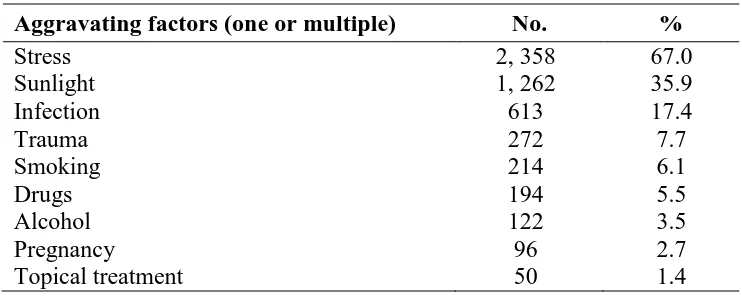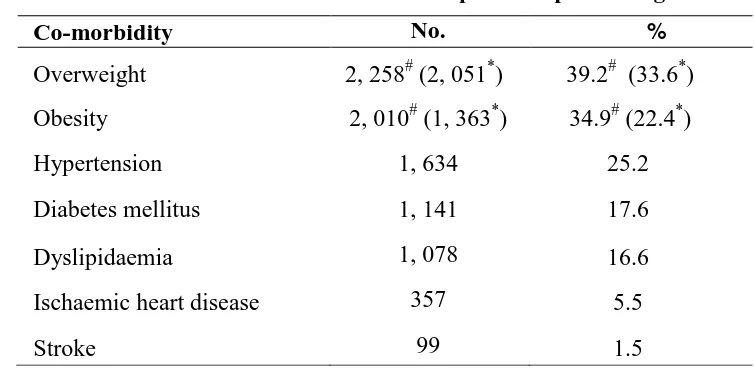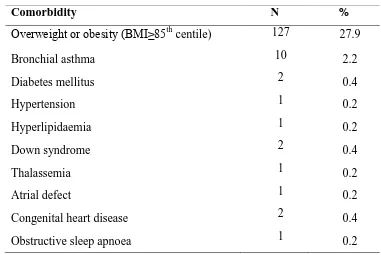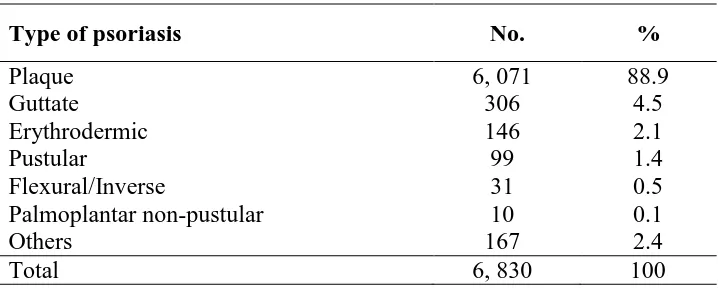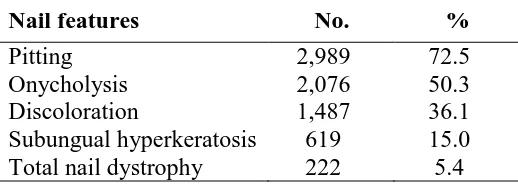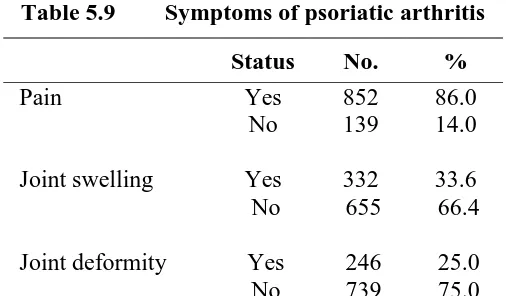Editors:
Azura Mohd Affandi
Fatimah `Afifah Alias
Asmah Johar
Roshidah Baba
Ministry of Health Malaysia
NATIONAL DERMATOLOGY REGISTRY
(DermReg)
Annual Report of the
MALAYSIAN PSORIASIS REGISTRY
2007 - 2011
Editors:
Azura Mohd Affandi Fatimah `Afifah Alias
Asmah Johar Roshidah Baba
With contribution from:
Jointly published by:
National Dermatology Registry (DermReg), Malaysia, and Clinical Research Centre (CRC), Ministry of Health, Malaysia
Contact:
National Dermatology Registry Department of Dermatology Hospital Kuala Lumpur Jalan Pahang
50586 Kuala Lumpur
Tel: 03-2615 5225 / 03-2615 5555 Ext 5225 Fax: 03-2698 5927
Email: [email protected]
Website:www.acrm.org.my/dermreg/
Disclaimer
The data reported here have been supplied by DermReg. The interpretation and reporting of these data are the responsibility of the Editor and in no way should be seen as an official policy or interpretation of the DermReg. This report is copyrighted. However it can be freely reproduced without the permission of the DermReg. Acknowledgement would be appreciated.
Suggested citation
The suggested citation for this report is as follows:
Mohd Affandi A, Alias FA, Johar A, Baba R. Annual Report of the Malaysian Psoriasis Registry 2007-2011, Kuala Lumpur, Malaysia 2013
Electronic version
Annual Report of the Malaysian Psoriasis Registry 2007-2011 i
ACKNOWLEDGMENT
We would like to thank the Director General of Health, Malaysia for permission to publish this report.
The National Dermatology Registry would like to give its appreciation to everyone who has helped in making this report possible.
We would also like to thank the following for their contribution and support:
All the doctors, allied health personnel and clerical staff in the participating centres
The Ministry of Health, Malaysia
The Dermatological Society of Malaysia
Clinical Research Centre (CRC), Ministry of Health, Malaysia
ii Annual Report of the Malaysian Psoriasis Registry 2007-2011
Governance Board viii
Steering Committee ix
Registry Coordinating Centre x
Source Data Providers xi
Official website xii
ABOUT MPR
CHAPTER 2: CHARACTERISTICS OF PATIENTS 7
CHAPTER 3: MEDICAL HISTORY 9
CHAPTER 4: COMORBIDITIES 13
CHAPTER 5: CLINICAL PRESENTATION 17
CHAPTER 6: TREATMENT 23
CHAPTER 7: QUALITY OF LIFE 27
CHAPTER 8: OUTCOMES 33
APPENDIX A: CASE REPORT FORM
Case Report Form 39
Biologic Treatment Initiation Form 43
Biologic Treatment Follow Up Form 45
APPENDIX B: DATA MANAGEMENT 47
APPENDIX C: STATISTICAL METHODS 53
Annual Report of the Malaysian Psoriasis Registry 2007-2011 iii
LIST OF TABLES
Table 1.1 Number of psoriasis patients notified from each participating centre 6
Table 1.2 Distribution of psoriasis patients according to the number of notifications 6
Table 2.1 Patient demographics 8
Table 3.1 Positive family history of psoriasis and its relationship with age of onset 11
Table 3.2 Family members with psoriasis 11
Table 3.3 Aggravating factors of psoriasis 12
Table 3.4 Infections which aggravated psoriasis 12
Table 3.5 Drugs which aggravated psoriasis 13
Table 4.1 Prevalence of comorbidities in adult psoriasis patients aged 18 and above 16
Table 4.2 Prevalence of comorbidities in psoriasis patients aged below 18 years 17
Table 4.3 Co-morbidities associated with psoriatic arthritis patients 17
Table 5.1 Distribution of psoriasis patients according to the type of psoriasis 21
Table 5.2 Distribution of percentage of body surface area affected in psoriasis patients 21
Table 5.3 Distribution of severity of body part affected of psoriasis patients 21
Table 5.4 Distribution of nail involvement in psoriasis patients 22
Table 5.5 Distribution of nail features in patients with nail involvement 22
Table 5.6 Distribution of joint disease in psoriasis patients 22
Table 5.7 Rheumatoid factor results in psoriasis patients with joint disease 22
Table 5.8 Distribution of types of joint disease 23
Table 5.9 Symptoms of psoriatic arthritis 23
Table 5.10 Distribution of types of joint deformities in patients with joint disease 23
Table 5.11 Factors associated with psoriatic arthritis 24
Table 6.1 Use of topical therapy in psoriasis patients 27
Table 6.2 Distribution of types of topical therapy 27
Table 6.3 Use of phototherapy in psoriasis patients 27
Table 6.4 Distribution of types of phototherapy 27
Table 6.5 Use of systemic therapy in psoriasis patients 28
Table 6.6 Distribution of types of systemic therapy in psoriasis patients 28
Table 7.1 Responses for DLQI in adult psoriasis patients (age 17 and above) 31
Table 7.2 Responses for CDLQI in child/adolescent psoriasis patients (aged 5 to 16) 33
Figure 7.3 Quality of life in children/adolescents with psoriasis 34
iv Annual Report of the Malaysian Psoriasis Registry 2007-2011
LIST OF FIGURES
Figure 1.1 Psoriasis patients notified to the MPR 5
Figure 1.2 Psoriasis patients notified to the MPR per year 5
Figure 3.1 Distribution of age of onset 11
Figure 7.1 Quality of life in adult patients with psoriasis 32
Figure 7.2 QoL impairment in adults psoriasis patients based on category of DLQI 32
Figure 7.3 Quality of life in children/adolescents with psoriasis 34
Figure 7.4 QoL impairment in child/adolescent psoriasis patients based on category 34
of DLQI
Figure 8.1 Improvement in the extent of skin lesions 38
Figure 8.2 Improvement in total clinical skin scores 38
Figure 8.3 Improvement in joint pain 39
Annual Report of the Malaysian Psoriasis Registry 2007-2011 v
ABBREVIATIONS
BB-UVB Broad-band ultraviolet B
BMI Body mass index
BSA Body surface area
CDLQI Child Dermatology Life Quality Index
CRC Clinical Research Centre
CRF Case report form
DermReg National Dermatology Registry
DLQI Dermatology Life Quality Index
eCRF Electronic case report form
eDermReg DermReg web application
HLA Human leukocyte antigen
IQR Interquartile range
MOH Ministry of Health
MPR Malaysian Psoriasis Registry
NA Not available
NBUVB Narrow-band ultraviolet B
NHMS National Health and Morbidity Survey
PI Principal Investigator
PUVA Psoralen and ultraviolet A
QoL Quality of life
RCC Registry Coordinating Centre
SC Site Coordinator
SD Standard deviation
vi Annual Report of the Malaysian Psoriasis Registry 2007-2011
ABOUT DermReg
Introduction
DermReg is an ongoing systematic collection, analysis and interpretation of data pertaining
to dermatological diseases and services in Malaysia. It is a nationwide project which aims to integrate all dermatological patient registries and databases developed in Malaysia. These registries are essential in the planning, implementation and evaluation of clinical and health services as well as research in dermatology
Objectives of DermReg
General Objective
To establish a nationwide systematic prospective collection of data pertaining to skin diseases and dermatological services, in order to study the natural history, outcome and quality of life issues of skin diseases, as well as the effectiveness, safety and accessibility of various treatment modalities.
Specific Objectives:
1. Determine the socio-demographic profile of patients with skin diseases
2. Determine the burden of skin diseases in the population
3. Describe the natural history of skin diseases
4. Identify the potential causal and risk factors of skin diseases
5. Describe the clinical manifestation of skin diseases
6. Describe the effect of skin diseases on the quality of life
7. Determine the efficacy and cost effectiveness of treatment of skin diseases
8. Monitor the safety and adverse effects of products and services used in the treatment
of skin diseases
9. Evaluate accessibility and quality of health services related to skin diseases
Annual Report of the Malaysian Psoriasis Registry 2007-2011 vii
ORGANISATION OF DermReg
The organizational structure of DermReg consists of sponsors, Governance Board, Steering Committee, Sub-committees or Expert Panels, Registry Coordinating Centre, Source Data Providers (SDP) and users.
SPONSORS
The DermReg is sponsored by:
1. Ministry of Health, Malaysia
2. Clinical Research Centre, Hospital Kuala Lumpur
3. The Dermatological Society of Malaysia
4. Pharma companies – Abbott Malaysia, Leo Pharma Malaysia and Janssen
viii Annual Report of the Malaysian Psoriasis Registry 2007-2011
GOVERNANCE BOARD
Governance Board of DermReg is a committee established by the sponsors. Its roles
are:
to ensure that the DermReg stay focused on its objectives
to ensure its continuing relevance and justification
1. Datuk Dr. Roshidah Baba (Chairperson)
Head of Dermatological Services and Senior Consultant Dermatologist Department of Dermatology
Hospital Melaka
2. Dr. Najeeb Ahmad Mohd Safdar
President of the Dermatological Society of Malaysia, and Consultant Dermatologist
Hospital Tuanku Jaafar, Seremban Negeri Sembilan
3. Dr. Steven Chow Kim Weng
President of the College of Physicians, Academy of Medicine Malaysia, and Senior Consultant Dermatologist
The Skin Centre, Kuala Lumpur
4. Dr. Goh Pik Pin
Annual Report of the Malaysian Psoriasis Registry 2007-2011 ix
STEERING COMMITTEE
Steering Committee for Malaysian Psoriasis Registry (MPR)
No. Name Institution
1. Dr Chang Choong Chor
(2007-Jul 2012)
Dr. Azura Mohd Affandi
(July 2012 – current)
Hospital Kuala Lumpur
2. Dr. Choon Siew Eng Hospital Sultanah Aminah, Johor Bahru
3. Dr. Pubalan Muniandy Hospital Umum Sarawak
4. Dr. Tang Jyh Jong Hospital Permaisuri Bainun, Ipoh
5. Dr. Chan Lee Chin Hospital Pulau Pinang
6. Dr. Najeeb Ahmad Mohd Safdar Hospital Tuanku Jaafar, Seremban
7. Dr. Steven Chow Kim Weng The Skin Clinic, Kuala Lumpur
x Annual Report of the Malaysian Psoriasis Registry 2007-2011
REGISTRY COORDINATING CENTRE
The DermReg Registry Coordinating Centre (RCC) is based at the Department of Dermatology, Hospital Kuala Lumpur. It coordinates the data collection among the source data providers, and collaborates with the Clinical Research Centre (CRC) that provides epidemiological and statistical support.
Registry Manager Fatimah „Afifah Alias
Technical Support Personnel
Epidemiology Officer Dr. Jamaiyah Haniff
Clinical Epidemiology Unit, CRC
Biostatisticians Ms Tassha Hilda bt Adnan CRC
Database Administrator Ms Lim Jie Ying
Annual Report of the Malaysian Psoriasis Registry 2007-2011 xi
SOURCE DATA PROVIDERS (SDP)
Source data providers (SDP) are centres that contribute data to the registries.
Source Data Providers for Malaysian Psoriasis Registry (MPR)
No. Source Data Provider Investigator
1. Hospital Kuala Lumpur Dr. Azura Mohd Affandi
2. Hospital Pulau Pinang Dr. Chan Lee Chin
3. Hospital Sultanah Bahiyah, Alor Setar Dr. Mani Mala a/p T. Manikam
4. Hospital Tuanku Fauziah, Perlis Dr. Sharifah Farihah Syed Abas
5. Hospital Sultanah Fatimah, Muar Dr. Siti Khadijah Abdul Wahid
6. Hospital Tuanku Jaafar, Seremban Dr. Najeeb Ahmad Mohd Safdar
7. Hospital Queen Elizabeth, Kota Kinabalu Dr. Zaigham Mahmood
8. Hospital Sungai Buloh Dr. Azahzuddin Hamzah
9. Hospital Tengku Ampuan Afzan, Kuantan Dr. Abu Razak Yusof
10. Hospital Permaisuri Bainun, Ipoh Dr. Tang Jyh Jong
11. Hospital Umum Sarawak, Kuching Dr. Pubalan Muniandy
12. Hospital Tengku Ampuan Rahimah, Klang Dr. Ng Ting Guan
13. Hospital Melaka Dr. Che Salmi Yusoff
14. Prince Court Medical Centre Dr.Gangaram Hemandas
15. Gleneagles Intan Medical Centre Dr. Chang Choong Chor
16. Hospital Sultanah Aminah, Johor Bahru Dr. Choon Siew Eng
17. Hospital Universiti Kebangsaan Malaysia Dr. Mazlin Mohd Baseri
xii Annual Report of the Malaysian Psoriasis Registry 2007-2011
OFFICIAL WEBSITE OF DermReg
Annual Report of the Malaysian Psoriasis Registry 2007-2011 xiii
ABOUT MALAYSIAN PSORIASIS REGISTRY (MPR)
Introduction
Psoriasis is a common skin disease, characterized by inflamed scaly patches and plaques. It runs a chronic relapsing course with variable degree of severity, and causes significant physical, psychosocial and economic impact on the patient. Being incurable, it may lead to poor patient compliance especially in treatment which will further compromise the overall management of the disease.
The Malaysian Psoriasis Registry (MPR) is a skin disease clinical registry. It is a prospective, ongoing systematic collection of data pertaining to patients who have psoriasis. The main reason for setting up a psoriasis registry is to have more accurate data on the various aspects of psoriasis in Malaysia. This would help in assessing the true magnitude of the problem in Malaysia, including the demographic data, types of psoriasis, its severity, aggravating factors, any associated joint and nail involvement and the various types of therapies commonly used. Having a psoriasis registry would also help in research work and more importantly in improving the overall management of the report of the registry (March 2000 to July 2005) was published in the Malaysian Journal of Dermatology in the August 2005 issue.
In 2007, MPR was extensively revised under the guidance of CRC and with the financial support from MOH. A new case report form was introduced and a new centralised electronic database with web application was established to facilitate multi-centre data collection. Preliminary report of the newly revised MPR was published in the Medical Journal of Malaysia in September 2008. The First Annual Report of MPR 2007-2008 was published in the following year.
Objectives
The MPR has the following objectives:
Primary objective:
xiv Annual Report of the Malaysian Psoriasis Registry 2007-2011
Secondary objectives:
1. To determine the socio-demographic profiles of patients with psoriasis.
2. To determine the disease burden attributed to psoriasis.
3. To provide information for planning of medical services, facilities, manpower and
training related to the management of psoriasis.
4. To stimulate and facilitate research on psoriasis and its management.
Scope of MPR
The MPR is intended to be a truly national population based disease and treatment registry. Hence it seeks the participation of all providers of dermatological services in both the public and private sectors in Malaysia.
The MPR collects:
Demographic data
Clinical data including patients' history and clinical examination findings
Quality of life measure i.e. Dermatology Life Quality Index (DLQI)
Modalities of treatment used
Outcomes of interest include:
Course of the disease
How the disease affects quality of life
Disease improvement with treatment
Association with any other diseases
Inclusion criteria:
1. All patients who are clinically diagnosed to have psoriasis by a registered
dermatologist or by a medical practitioner under the supervision of a dermatologist are included. Confirmation of diagnosis by histopathologic examination is optional.
Exclusion criteria:
Annual Report of the Malaysian Psoriasis Registry 2007-2011 1
EXECUTIVE SUMMARY
Stock and Flow
During the period from October 2007 to December 2011, a total of 6,985 patients with psoriasis from 19 dermatology centres (15 governments, 2 private centres and 2 university hospitals) were notified to the registry.
Demographic Characteristics of Patients
Male-to-female ratio was 1.3:1. Ethnic distribution: Malay 50.2%, Chinese 22.3%, Indian 18.1%, other ethnic groups 9.3% and Orang Asli 0.1%. Mean age at notification was 43 ± 17.33 years (range 0 - 97 years). Most patients (99.1%) were Malaysian citizens.
Medical History
Mean age of onset of psoriasis was 33.3 ± 16.7 years (range 0 – 85 years). Family history of
psoriasis was present in 20.1% of the patients. Positive family history was more common among patients with younger onset (aged 40 and below) compared to those with later onset of disease: 15.5% vs 4.5%. Among those who had positive family history, family members affected were either of their parents in 41.8%, siblings in 36.7% and children in 10.6%.
51.1% of the patients reported one or multiple factors which aggravated their psoriasis. The commonest aggravating factors were stress (67.0%), sunlight (35.9%) and infection (17.4%).
Comorbidities
In adult psoriasis patients aged 18 and above, the common comorbidities were overweight 33.6%, obesity 22.5%, hypertension 25.4%, diabetes mellitus 17.8%, hyperlipidaemia 16.6%, and ischaemic heart disease 5.6%. In patients aged below 18, the commonest comorbidity was overweight or obesity (27.9 %), bronchial asthma (2.2%) followed by diabetes mellitus
(0.4%) down syndrome (0.4%) and congenital heart disease (0.4%).
Clinical Presentation
The commonest clinical type of psoriasis was plaque psoriasis (88.9%). This was followed by guttate psoriasis (4.5%), erythrodermic psoriasis (2.1%), pustular psoriasis (1.4%) and flexural psoriasis (0.5%). The majority of patients (75.9%) had body surface area involvement of 10% or less.
Psoriatic arthropathy was reported in 15.0% of patients. The commonest psoriatic arthropathy
was oligo/monoarthropathy (49.1%) followed by rheumatoid-like symmetrical
polyarthropathy (36.4%) and distal hand joints arthropathy (31.4%). Spondylitis/sacroilitis accounted for only 11.1% of cases and arthritis mutilans in 3.4% of patients.
2 Annual Report of the Malaysian Psoriasis Registry 2007-2011
Treatments received in the past 6 months
72.6% of the patients were on topical treatment only. Topical steroid was the commonest prescribed (85.4%), followed by tar preparations in 80.7% and emollients in 74.7% of patients. 4.1% of patients received phototherapy. Of the patients who had phototherapy, narrowband UVB (NBUVB) was the commonest used (72.8%). Oral psoralen and ultraviolet A (PUVA) was used in 4.0% of patients only. Systemic therapy was given in 19.6% of patients. The most frequently used systemic therapy was methotrexate (67.8%), followed by acitretin (20.8%), systemic corticosteroids (6.3%), sulphasalazine (6.2%), cyclosporine (4.5%), biologics (1.9%) and hydroxyurea (1.2%).
Quality of Life
Chapter 1 : Stock and Flow
Annual Report of the Malaysian Psoriasis Registry 2007-2011 3
CHAPTER 1
Chapter 1: Stock and Flow
4 Annual Report of the Malaysian Psoriasis Registry 2007-2011
During the period from October 2007 to December 2011, a total of 6,985 patients were notified to the registry. The number of notified patients gradually increased throughout the period (Figure 1.1). The number of patients notified per year is illustrated in Figure 1.2.
A total of 19 dermatology centres (15 government, 2 private centres and 2 university hospital) participated in the MPR. Department of Dermatology, Hospital Kuala Lumpur notified the highest number of patients. This was followed by Hospital Pulau Pinang and Hospital Tengku Ampuan Rahimah, Klang (Table 1.1).
Chapter 1 : Stock and Flow
Annual Report of the Malaysian Psoriasis Registry 2007-2011 5
Figure 1.1 Psoriasis patients notified to the MPR
Chapter 1: Stock and Flow
6 Annual Report of the Malaysian Psoriasis Registry 2007-2011
Table 1.1 Number of psoriasis patients notified from each participating centre No. of patients notified
2007 2008 2009 2010 2011 Total
Table 1.2 Distribution of psoriasis patients according to the number of notifications
Year No. %
Entry notification 5, 042 72.2
Entry and one follow-up notifications 1 , 166 16.7
Entry and 2 follow-up notifications 448 6.4
Entry and 3 follow-up notifications 175 2.5
Entry and 4 follow-up notifications 99 1.4
Entry and 5 follow-up notifications 38 0.5
Entry and 6 follow-up notifications 16 0.2
Entry and 7 follow-up notifications 1 0.0
Chapter 2: Characteristics of patients
Annual Report of the Malaysian Psoriasis Registry 2007-2011 7
CHAPTER 2
Chapter 2: Characteristics of Patients
8 Annual Report of the Malaysian Psoriasis Registry 2007-2011
There were more males than females (56.5% and 43.5% respectively), with a male to female ratio of 1.3:1. Malays comprised the majority of patients (50.2%), followed by Chinese (22.3) Indians (18.1%), other ethnic groups (9.3%) and Orang Asli (0.1%).
The mean age at presentation to the clinic was 43.0 ± 17.33 years with a range from 0 to 97 years. The majority were married (67.0%), 28.5% were single, and the rest, either divorced or widowed (Table 2.1).
Table 2.1 Patient demographics
Patient characteristics No %
Chapter 3: Medical History
Annual Report of the Malaysian Psoriasis Registry 2007-2011 9
CHAPTER 3
Chapter 3: Medical History
10 Annual Report of the Malaysian Psoriasis Registry 2007-2011
Onset of Psoriasis
Psoriasis may first appear at any age. In the MPR, 67.0% of patients had first symptoms of
psoriasis by the age of 40. The mean age of onset in our cohort was 33.3 ± 16.7 years with a
wide range from 0 to 85 years (Figure 3.1). The mean interval between onset (as reported by patient) and diagnosis (first diagnosed by physician) was 2.12 ± 4.5 years.
Family History
Psoriasis is a skin disorder with a polygenic mode of inheritance. In our registry, about one-fifth (20.1%) of patients had at least one family member who has psoriasis (Table 3.1). Of those with a positive family history, 41.8% had either of their parents affected. Siblings were affected in 36.7% and children in 10.6% (Table 3.2). More patients with positive family history were observed among those with a younger onset of disease (aged 40 and below) compared to those with later onset of disease: 15.5% vs 4.5% (Table 3.1).
Aggravating factors of psoriasis
51.1% of patients reported one or multiple factors which worsened their psoriasis. Stress was the commonest aggravating factor (67.0%), followed by sunlight (35.9%) and infection
(17.4%). Other identified aggravatingfactors included trauma (7.7%), smoking (6.1%), drugs
(5.5%), alcohol (3.5%), pregnancy (2.7%) and topical treatment (1.4%) (Table 3.3).
Analyzing the subgroup of patients who reported infection as an aggravating factor, upper respiratory tract infection (13.2%) appeared to be the commonest infective trigger (Table
3.4). Common medications found to aggravate psoriasis were withdrawal of systemic steroids
Chapter 3: Medical History
Annual Report of the Malaysian Psoriasis Registry 2007-2011 11
Figure 3.1 Distribution of age of onset
Table 3.1 Positive family history of psoriasis and its relationship with age of onset
Overall Age of onset of psoriasis
40 & below Above 40
No. % N % N %
Family members with psoriasis
Yes 1, 390 20.1 1, 067 15.5 310 4.5
No 5, 533 79.9 3, 537 51.5 1, 958 28.5
Total 6, 923 100 4, 604 67.0 2, 268 33.0
Table 3.2 Family members with psoriasis
Family member (one or multiple) No. %
Father 365 26.3
Mother 215 15.5
Sibling(s) 510 36.7
Children 148 10.6
Chapter 3: Medical History
12 Annual Report of the Malaysian Psoriasis Registry 2007-2011
Table 3.3 Aggravating factors of psoriasis
Aggravating factors (one or multiple) No. %
Stress 2, 358 67.0
Table 3.4 Infections which aggravated psoriasis
Infection No. %
Upper respiratory tract infection 81 13.2
Febrile illness 23 3.8
Table 3.5 Drugs which aggravated psoriasis
Drug N %
Systemic steroids (withdrawal) 37 30.6
Beta-blocker 32 26.4
Traditional/ Homeopathy 13 10.7
NSAIDs / analgesics 11 9.2
Antibiotic 10 8.3
Antimalarial drug 3 2.5
ACE inhibitor 3 2.5
Oral contraceptive pill 2 1.7
Topical tar preparation 2 1.7
Sodium valporate 1 0.8
Daivobet 1 0.8
“Gamat” (Sea cucumber extract) 1 0.8
Chapter 4: Comorbidities
Annual Report of the Malaysian Psoriasis Registry 2007-2011 13
CHAPTER 4
Chapter 4: Comorbidities
14 Annual Report of the Malaysian Psoriasis Registry 2007-2011
Patients with psoriasis were found to have a number of other concomitant diseases. As the spectrum of diseases differs among age groups, adult and children/adolescent patients were analysed separately.
In adult psoriasis patients aged 17 and above, 33.6% were overweight and 22.5% were obese. 25.4% patients had hypertension, 17.8% had diabetes mellitus, 16.6% had dyslipidaemia, 5.6% had ischaemic heart disease and 1.5% had previous history of stroke (Table 4.1).
In children and adolescents aged below 17 years with psoriasis, the most prevalent
comorbidity was overweight or obesity i.e. BMI at or above 85th centile (27.9 %), followed
by bronchial asthma (2.2%) and diabetes mellitus (0.4%), Down syndrome (0.4%) and congenital heart disease (0.4%). Other comorbid conditions were much less common (Table
4.2).
Compared to patients without arthritis, patients with psoriatic arthritis were found to have increased co-morbidities such as diabetes mellitus, hypertension, hyperlipidaemia and obesity (p < 0.001) (Table 4.3).
Table 4.1 Prevalence of comorbidities in adult psoriasis patients aged 17 and above
Co-morbidity No. %
Ischaemic heart disease 357 5.5
Stroke 99 1.5
#
according to BMI classification for adult Asians as stated in the Clinical Practice Guidelines on Management of Obesity 2004, Ministry of Health, Malaysia
Chapter 4: Comorbidities
Annual Report of the Malaysian Psoriasis Registry 2007-2011 15
Table 4.2 Prevalence of comorbidities in psoriasis patients aged below 17 years
Comorbidity N %
Overweight or obesity (BMI≥85th
centile) 127 27.9
Bronchial asthma 10 2.2
Diabetes mellitus 2 0.4
Hypertension 1 0.2
Hyperlipidaemia 1 0.2
Down syndrome 2 0.4
Thalassemia 1 0.2
Atrial defect 1 0.2
Congenital heart disease 2 0.4
Obstructive sleep apnoea 1 0.2
Table 4.3 Co-morbidities associated with psoriatic arthritis patients
Co-morbidities
*Result was based on available information. Percentage (%) was calculated based on number of cases over total number for each group (absent or present).
a
Wald statistic.
Chapter 4: Comorbidities
Chapter 5: Clinical Presentation
Annual Report of the Malaysian Psoriasis Registry 2007-2011 17
CHAPTER 5
Chapter 5: Clinical Presentation
18 Annual Report of the Malaysian Psoriasis Registry 2007-2011
Plaque psoriasis was the commonest type of psoriasis (88.9%). This was followed by guttate psoriasis (4.5%) and erythrodermic psoriasis (2.1%). Pustular and flexural/inverse psoriasis were much less common, constituting 1.4% and 0.5% respectively (Table 5.1).
Majority of our patients had mild to moderate body surface area involvement. 34.8% of our psoriatic patients had <5% BSA affected, while 41.1% had 5-10% of BSA affected. Severe psoriasis with >10% BSA affected occurred in 21.8% patients, while 2.3% had erythrodermic psoriasis, i.e. >90% BSA involved (Table 5.2).
A composite clinical scoring system was used to evaluate the severity of psoriatic lesions in five body regions. A score of 0 to 3 was given for each body region according to the degree of erythema, thickness and scaliness of the skin lesions. The total clinical score may range from 0 to 15. Analysis on severity of lesion noted that most of the moderate to severe lesions (score 2 and 3) located on lower limb (37.0%), trunk (33.2%) and upper limb (29.3%). Half of our psoriatic patients (51.3%) did not have any lesion on the face and neck. If present, lesions on face and neck were generally less severe (score 1 or 2) (Table 5.3).
Majority of patients with psoriasis had nail involvement (59.8%) (Table 5.4). Among patients who had psoriatic nail disease, most of them had pitting (72.5%). Other common features were onycholysis (50.3%), discoloration (36.1%) and subungual hyperkeratosis (15.0%). Total nail dystrophy was found in 5.4% of patients with nail involvement (Table
5.5).
Joint disease related to psoriasis was reported in 15.0% of the patients (Table 5.6). Rheumatoid factor was detected in 1.8% of patients with arthropathy who were tested (Table
5.7). The commonest clinical pattern of psoriatic arthropathy was oligo-/monoarthropathy
(49.1%). This was followed by rheumatoid-like symmetrical polyarthropathy (36.4%), distal hand joints arthropathy (31.4%), spondylitis (11.1%) and arthritis mutilans (3.4%). Morning stiffness was observed in 31.5% and enthesopathy in 9.9% (Table 5.8).
Most of the patients with psoriatic arthropathy experienced joint pain at time of presentation (86.0%) (Table 5.9). Joint swelling was present in 33.6%, while joint deformity occurred in 25.0% (Table 5.9). The commonest type of joint deformity was swan neck deformity (27.9%). This was followed by Boutonniere deformity (15.4%), fixed flexion deformity (14.7%), distal hand joint deformity (8.1%), rheumatoid arthritis-like (5.1%) and proximal interphalangeal joint deformity (2.9%). Bamboo spine and arthritis mutilans were observed in only 2.2% of patients (Table 5.10).
By using multiple logistic regressions, 10 factors were found to be associated with psoriatic
arthritis. These were age (>18 years), age of onset (≤40 years), duration of disease (> 5
Chapter 5: Clinical Presentation
Annual Report of the Malaysian Psoriasis Registry 2007-2011 19
Table 5.1 Distribution of psoriasis patients according to the type of psoriasis
Type of psoriasis No. %
Plaque 6, 071 88.9
Guttate 306 4.5
Erythrodermic 146 2.1
Pustular 99 1.4
Flexural/Inverse 31 0.5
Palmoplantar non-pustular 10 0.1
Others 167 2.4
Total 6, 830 100
Table 5.2 Distribution of percentage of body surface area affected in psoriasis patients
Table 5.3 Distribution of severity of body part affected in psoriasis patients
Body part
Table 5.4 Distribution of nail involvement in psoriasis patients. Nail involvement No. %
Yes 4,124 59.8
No 2,773 40.2
Chapter 5: Clinical Presentation
20 Annual Report of the Malaysian Psoriasis Registry 2007-2011
Table 5.5 Distribution of nail features in patients with nail involvement
Nail features No. %
Pitting 2,989 72.5
Onycholysis 2,076 50.3
Discoloration 1,487 36.1
Subungual hyperkeratosis 619 15.0
Total nail dystrophy 222 5.4
Table 5.6 Distribution of joint disease in psoriasis patients Joint disease No. %
Yes 1,034 15.0
No 5,849 85.0
Total 6, 883 100
Table 5.7 Rheumatoid factor results in psoriasis patients with joint disease
Rheumatoid factor No. %
Positive 17 1.8
Negative 196 21.1
Not available 717 77.1
Total 930 100
Table 5.8 Distribution of types of joint disease
Type of joint disease (one or multiple) No. %
Oligo-/monoarthropathy 466 49.1
Symmetrical polyarthropathy (rheumatoid-like) 342 36.4
Morning stiffness > 30 mins 294 31.4
Distal hand joints arthropathy 294 31.4
Spondylitis 102 11.1
Enthesopathy 91 9.9
Chapter 5: Clinical Presentation
Annual Report of the Malaysian Psoriasis Registry 2007-2011 21
Table 5.9 Symptoms of psoriatic arthritis
Status No. %
Pain Yes 852 86.0
No 139 14.0
Joint swelling Yes 332 33.6
No 655 66.4
Joint deformity Yes 246 25.0
No 739 75.0
Table 5.10 Distribution of type of joint deformities in patients with joint disease
Type of joint deformity No. %
Swan neck deformity 38 27.9
Boutonniere deformity 21 15.4
Fixed-flexion deformity 20 14.7
Distal hand joint deformity 11 8.1
Rheumatoid arthritis-like 7 5.1
Proximal interphalangeal joint deformity 4 2.9
Bamboo spine 3 2.2
Arthritis mutilans 3 2.2
Others 29 21.3
Chapter 5: Clinical Presentation
22 Annual Report of the Malaysian Psoriasis Registry 2007-2011
Table 5.11 Factors associated with psoriatic arthritis
Variable
*Result was based on available information. Adj. OR = Adjusted odds ratio.a Forward LR was applied. Multicollinearity was
Chapter 6: Treatments
Annual Report of the Malaysian Psoriasis Registry 2007-2011 23
CHAPTER 6
Chapter 6: Treatments
24 Annual Report of the Malaysian Psoriasis Registry 2007-2011
Types of treatment received by the patients for psoriasis in the last six months were analysed.
Most patients (96.3%) used some form of topical medications for psoriasis (Table 6.1). In 72.6% of the patients, topical monotherapy was the only treatment given. The most commonly used topical medication was topical steroids (85.4%). This was followed by topical tar preparation (80.7%), emollients (74.7%), keratolytics (54.8%) and vitamin D analogue such as calcipotriol (26.0%). Dithranol was less favoured and used in 1.9% of patients only (Table 6.2).
In the last six months prior to notification, 4.1% of patients received phototherapy (Table
6.3). Most of these patients (72.8%) were given narrowband UVB (NB-UVB) while 8.1%
were given broadband UVB (BB-UVB). Less popular modalities were oral PUVA (4.0%), topical PUVA (1.1%) and bath PUVA (0.4%) (Table 6.4).
Chapter 6: Treatments
Annual Report of the Malaysian Psoriasis Registry 2007-2011 25
Table 6.1 Use of topical therapy in psoriasis patients Topical therapy No. %
Yes 6726 96.3
No 259 3.7
Total 6985 100.0
Table 6.2 Distribution of types of topical therapy
Topical therapy (one or multiple) No. %
Topical steroids (other than face and flexures) 5,742 85.4
Tar preparation 5,428 80.7
Emollient 5,021 74.7
Keratolytics 3,683 54.8
Vitamin D analogues 1,749 26.0
Dithranol (anthralin) 130 1.9
Others 160 2.4
Table 6.3 Use of phototherapy in psoriasis patients
Table 6.4 Distribution of types of phototherapy
Phototherapy No. %
Yes 272 4.1
No 6,435 95.9
Total 6, 707 100
Type of phototherapy (one or multiple) No. %
Chapter 6: Treatments
26 Annual Report of the Malaysian Psoriasis Registry 2007-2011
Table 6.5 Use of systemic therapy in psoriasis patients Systemic therapy No. %
Yes 1, 336 19.6
No 5, 493 80.4
Total 6, 829 100
Table 6.6 Distribution of types of systemic therapy in psoriasis patients
Type of systemic therapy (one or multiple) No. %
Methotrexate 906 67.8
Acitretin 278 20.8
Sulphasalazine 83 6.2
Cyclosporin 60 4.5
Hydroxyurea 16 1.2
Biologics 25 1.9
Systemic corticosteroids 84 6.3
Chapter 7: Quality of Life
Annual Report of the Malaysian Psoriasis Registry 2007-2011 27
CHAPTER 7
Chapter 7: Quality of Life
28 Annual Report of the Malaysian Psoriasis Registry 2007-2011
There were a total of 4,295 adult patients (aged 17 and above) and 245 child/adolescent patients who completed the quality of life questionnaires, namely Dermatology Life Quality Index (DLQI) and Child Dermatology Life Quality Index (CDLQI).
The mean DLQI for adult psoriasis patients was 8.5 ± 6.4, and the mean CDLQI for child/adolescent patients was 7.6 ± 5.5.
The responses for each question of the DLQI and CDLQI were tabulated in Table 7.1 and 7.2 respectively. 1,391 adult patients (32.4%) reported a DLQI of more than 10 indicating severe quality of life impairment due to psoriasis or its treatment (Figure 7.1). There were 230 adults (5.4%) who had a DLQI of more than 21 indicating extremely large effect on their quality of life by psoriasis. Nevertheless, 13.5% of adult patients reported no effect at all on their quality of life.
As shown in Figure 7.2, “systems and feelings” was the DLQI category most affected by
psoriasis in adult patients. 37.5% of patients were affected very much or a lot by the itch and pain as well as embarrassment due to psoriasis. The aspect of life least affected by psoriasis
was “personal relationship” in which 74.1% of the adult patients did not have or only have a
little effect in this aspect.
In children/adolescents group, 18.0% of patients reported a CDLQI of more than 12 indicating very large or extremely large effect on QoL (Figure 7.3). There were 11 patients (4.5%) who had CDLQI of more than 19, reflecting extremely large effect of QoL. On the other hand, 12.7% child/adolescent patients reported no effect at all on their QoL.
In child/adolescent patients, the category of CDLQI most affected was “symptoms and feelings”. 43.4% of children/adolescents reported that psoriasis affected very much or a lot in
the symptoms and feelings domain. The aspect of life least affected by psoriasis was
“personal relationship” in which 74.7% of the children did not have or only have a little
Chapter 7: Quality of Life
Annual Report of the Malaysian Psoriasis Registry 2007-2011 29 Table 7.1 Responses for DLQI in adult psoriasis patients (age 17 and above)
No. DLQI Question
painful, or stinging has your skin been?
2 Over the last week, how embarrassed or self conscious have you been because of your skin? your skin interfered with you going shopping or looking after your home or garden? your skin influenced the clothes you wear? your skin affected any social or leisure activities? your skin made it difficult for you to do any sport? prevented you from working or studying? your skin created problems with your partner or any of your close friends or relatives? your skin caused sexual difficulties?
203
Chapter 7: Quality of Life
30 Annual Report of the Malaysian Psoriasis Registry 2007-2011
Figure 7.1 Quality of life in adult patients with psoriasis
Figure 7.2 QoL impairment in adults psoriasis patients based on category of DLQI
221
1,062
1,127
Chapter 7: Quality of Life
Annual Report of the Malaysian Psoriasis Registry 2007-2011 31 Table 7.2 Responses for CDLQI in child/adolescent psoriasis patients (aged 5 to 16)
No. CDLQI Question
No. (%)
“scratchy”, sore, painful, or stinging has your skin been?
29
2 Over the last week, how embarrassed or self conscious have you been because of your skin? your skin affected your friendships?
16 you changed or worn different or special clothes/shoes because of your skin? your skin trouble affected going out, playing, or doing hobbies?
20 you avoided swimming or other sports because of your skin trouble?
24 how much did your skin problem affect your school work?
Or
If holiday time: Over the last week, has your skin problem interfered with your enjoyment of the holiday?
14
Chapter 7: Quality of Life
32 Annual Report of the Malaysian Psoriasis Registry 2007-2011
Figure 7.3 Quality of life in children/adolescents with psoriasis.
Figure 7.4 QoL impairment in child/adolescent psoriasis patients based on category of DLQI
31
88
76
31
Chapter 8: Outcomes
Annual Report of the Malaysian Psoriasis Registry 2007-2011 33
CHAPTER 8
Chapter 8: Outcomes
34 Annual Report of the Malaysian Psoriasis Registry 2007-2011
In this registry, follow-up data were collected approximately every 6 months. Outcomes of patients were assessed by measuring the change in several clinical parameters between the last follow-up visit and the visit at registration. Severity of psoriasis skin lesions were assessed in terms of the extent of lesions, i.e. percentage of body surface area involvement, and lesional characteristics via clinical skin scoring method for each of the five body regions. Other clinical parameters monitored include severity of joint pain on a visual analogue score (0-10), and quality of life using Dermatology Life Quality Index (DLQI).
From a total of 6,985 psoriasis patients registered in MPR, follow-up data were obtained in
1,936 patients. The mean duration of follow-up was 19.7 ± 12.2 months, with the longest duration of 36 months (Table 8.1).
Extent of Psoriasis Lesions
The extent of psoriasis lesions was assessed in terms of percentage of body surface area involvement categorised into 4 scales, i.e. <5%, 5%-10%, 10%-90%, and >90% (erythrodermic). A total of 1, 342 patients were evaluated for change in the extent of lesions. Of these patients, 318 patients (23.7%) had improvement by at least one scale, among which 57 (4.2%) had improvement by two scales, and 3 patients improved from BSA>90% to BSA<2%. No improvement was found in 721 patients (53.7%), and 243 patients (18.1%) had worsening by at least one scale (Figure 8.1).
Clinical Skin Scores
Clinical skin scores measures the thickness, erythema and scaliness of the psoriasis lesions in each of the five body regions. A score of 0 to 3 is given for each body region. Total Clinical Skin Score is the total of the scores in all five body regions. 124 patients (7.7%) had the most marked improvement in skin scores by 75% or more, and 364 patients (22.6%) had improvement by 50-75%, while 335 patients (14.9%) had 25-50% improvement. 166 patients (11.1%) had modest improvement of less than 25%. No improvement of skin scores were detected in 359 patients (19.5%). Skin scores worsened in 535 patients (24.1%) (Figure 8.2).
Joint Pain
From a total of 130 patients who reported to have joint pain, 63 patients (48.5%) had improvement in joint pain as measured by the visual analogue scale. Of these patients, 21 patients (16.2%) had improvement of between 50% and 75%, 2 patients (1.5%) had improvement of more than 75%, 27 patients (20.8%) had improvement of between 25% and 50%, and 13 patients (10.0%) had improvement of less than 25%. There was no improvement of joint pain in 31 patients (23.8%), while joint pain worsened in 36 patients (27.7%) (Figure
8.3).
Change in Quality of Life
Chapter 8: Outcomes
Annual Report of the Malaysian Psoriasis Registry 2007-2011 35 A total of 61 patients aged below 17 were evaluated for change in quality of life by DLQI. Of these patients, 14 patients (23.0%) had a significant improvement of Child DLQI score by at least 5, while 5 patients (8.3%) worsened (Figure 8.4).
Table 8.1 Distribution of psoriasis patients according to the duration of follow-up
Duration of follow-up No. %
0 to 6 months 271 14.0
7 to 12 months 459 23.7
13 to 18 months 362 18.7
19 to 24 months 267 13.8
25 to 30 months 192 9.9
31 to 36 162 7.9
>36 233 12.0
1936 100.0
Chapter 8: Outcomes
36 Annual Report of the Malaysian Psoriasis Registry 2007-2011
Figure 8.1 Improvement in the extent of skin lesions
Chapter 8: Outcomes
Annual Report of the Malaysian Psoriasis Registry 2007-2011 37
Figure 8.3 Improvement in joint pain
Chapter 8: Outcomes
Appendix A: Case Report Form
Annual Report of the Malaysian Psoriasis Registry 2007-2011 39 APPENDIX A: CASE REPORT FORM
Appendix A: Case Report Form
Appendix A: Case Report Form
Appendix A: Case Report Form
Appendix A: Case Report Form
Appendix A: Case Report Form
Appendix A: Case Report Form
Appendix A: Case Report Form
Appendix B: Data Management
Annual Report of the Malaysian Psoriasis Registry 2007-2011 47
APPENDIX B: DATA MANAGEMENT
The National Dermatology Registry (DermReg) maintains a database that includes
patient‟s demographic data, medical history, comorbidities, clinical presentation, treatments received in the past 6 months and quality of life. Data is stored in SQL Server due to the high volume of data accumulated throughout the years.
Data Sources
SDPs of DermReg comprise of dermatology centres or clinics with dermatologists who participate in the registry throughout Malaysia.
Data Collection
The study involves collection of data on the patient‟s first visit to the participating
centre and thereafter every six monthly on follow-up visits.
A carefully designed Case Report Form (CRF) is employed in the data collection. This is a double-sided single-sheet CRF which consists of a clinical data form and a multilingual Dermatology Life Quality Index (DLQI) form in both adult and children versions. The clinical data form is to be completed by the doctor in-charge while the DLQI form is to be completed by the patient (parent or guardian for young patient) with guidance from trained staff if necessary. Adult DLQI form should be used for patients above 16 years old, while Children DLQI for patients aged 5 to 16. It is not required to fill the DLQI form for patients below 5 years of age.
One set of CRF is to be completed for each new patient during consultation at the first visit to the participating centre. A new set of CRF is to be completed for the same patient every 6 monthly to record the progress of the patient. The CRFs are used as part of the clinical records.
The CRF is to be completed in duplicate. The participating centre retains the duplicate
copy in the patient‟s medical record, while the original copy is to be sent within 2 weeks to the RCC where data are analysed, interpreted and presented in regular reports to be disseminated to the users.
Appendix B: Data Management
48 Annual Report of the Malaysian Psoriasis Registry 2007-2011
Registry ICT Infrastructure and Data Centre
The operations of the DermReg are supported by an extensive ICT infrastructure to ensure operational efficiency and effectiveness.
The network infrastructure consists of the network layout, placement of relevant hardware equipment, the general flow of data across the network, as well as the network services required for a functional and secure DermReg network infrastructure. DermReg servers are located in a data centre in Cyberjaya in order to provide DermReg with quality assured data hosting services and state-of-the-art physical and logical security features without having to invest in costly data centre setup internally. The physical security features implemented include fire suppression system, access card and biometrics authentication to gain physical access to the data centre, uninterrupted power supply, and backup devices. Logical security features implemented include firewall, antivirus, automated patching, encryption, traffic monitoring and intrusion detection system.
Data Flow Process
Data are collected by doctors in the dermatology departments or clinics. Completed CRFs are then sent to the RCC.
Data received by the RCC are manually reviewed and checked for completeness and
error. Data without apparent problems are entered into the registry database. Edit checks are performed periodically to identify potential data errors, such as missing data, non-allowed values, out of range numeric values, inconsistent data and error with deduplication. Data queries that are resolved are then updated to the database.
SDP: Dermatology departments / clinics
Data collection is performed where CRFs are filled.
Site coordinators monitor and collect completed CRFs and send to RCC.
RCC
Data verification and entry
Data analysis and interpretation
Users
Appendix B: Data Management
Annual Report of the Malaysian Psoriasis Registry 2007-2011 49 To ensure complete enumeration and validity of data, a series of tasks as shown in the figure below have to be in place.
Data Receipt
Pre-entry Manual Review
Data Entry
Edit Checks Run and Data Cleaning
Data Editing
Data Deduplication
Database lock
Data Analysis and Report Writing
Appendix B: Data Management
50 Annual Report of the Malaysian Psoriasis Registry 2007-2011
SDP Data Reporting, Data Correction and Submission Tracking
Data submitted by SDP are entered into electronic case report form (eCRF) via DermReg Web Application (eDermReg).
There are a number of data security features that are designed into eDermReg such as web owner authentication, two-level user authentication, access control, data encryption, session management to automatically log off the application, audit trail and data backup and disaster recovery plan.
Prior to registering a patient record, a verification process is done by using the search functionality to search if patient exist in the entire registry. This step is done to avoid duplicate records. For patients that exist in the database, SDP only needs to add a new notification with basic patient particulars pre-filled based on existing patient information in the database.
There are a few built-in functionalities at the data entry page that serve to improve data quality. One such function is auto calculation which reduces errors in human calculation. There is also inconsistency check functionality that disables certain fields if these fields are answered in a certain manner. When value entered is not within the specific range, user is prompted for the correct value.
Real time reports are also provided in the web application. The aggregated data reports are presented in the form of tables and graphs manner. These aggregated data reports are
Appendix B: Data Management
Annual Report of the Malaysian Psoriasis Registry 2007-2011 51
Edit checks run and Data cleaning
Edit check was performed periodically by the registry manager to identify missing compulsory data, out of range values, inconsistency data, invalid values and error with de-duplication. Data cleaning is then performed based on the results of edit checks. Data update and data checking of the dataset is performed when there is a query of certain fields when necessary. It could be due to request by user, correction of data based on checking from data query in eCRF or after receiving results from preliminary data analysis. During data standardization, missing data are handled based on derivation from existing data. For example, deriving age from IC, deriving gender from IC and name and inferring race from name. Checking inconsistency of the data also done, for example IC and name shows female but gender is male. Data de-duplication is also performed to identify duplicate records in the database that might have been missed by the SDP.
Legal Aspects and Confidentiality
Data transfer from source data producers is entirely voluntary. There is no legal provision to compel any individual or institution to report or transfer its data to the RCC. The data transferred to RCC is highly sensitive and has to be kept strictly confidential with access only to authorized individual working in the RCC. Strict data protection procedure will need to be put in place, following standard disease registration practice, and in compliance with applicable regulatory guidelines.
Data release policy
Appendix B: Data Management
Appendix C: Statistical Methods
Annual Report of the Malaysian Psoriasis Registry 2007-2011 53
APPENDIX C: STATISTICAL METHODS
ANALYSIS SET
This refers to the set of cases included in the analysis. Two analysis sets were defined:
1. Patient notification between 2007 and 2011
There were 6,985 patients in the dataset. The analysis set was use for the analysis in
Chapter 1, 2, 3, 4, 5 and 6, which comprises of 316 cases in year 2007, 1,283 cases in year 2008, 1,758 cases in year 2009, 1,807 in year 2010 and 1,821 in year 2011. The cases include first notification and up to five follow-up notifications.
2. Patient outcome between 2007 and 2011
There were 1, 936 cases considered for the outcome analysis in Chapter 8.
DATA MANAGEMENT
Data Cleaning
The data from the MPR database were subjected to extensive checking prior to definitive analysis. Errors found or queries raised were checked against the database and/or CRF and corrections were made immediately.
Missing Data
Appendix C: Statistical Methods
54 Annual Report of the Malaysian Psoriasis Registry 2007-2011
STATISTICAL METHOD
Descriptive analysis was done in presenting frequencies and percentages of distribution whereas bar and pie charts were used in presenting the figures. For continuous data, the mean, standard deviation, minimum, maximum, median and interquartile range were reported. For standardization in output table, the values of percentages and summary descriptive were limited to one decimal point only. The summaries of data presentation by chapter were described as below:
Stock and Flow
Chapter 1 explained the registry for the distribution of centres reported and distribution of patients according to number of notifications.
Characteristics of Patients
Chapter 2 explained the socio-demographic profiles such as gender, ethnicity, nationality and marital status. Descriptive summary was done for age at visit.
Medical History
Chapter 3 emphasized on the distribution of aggravating factors of psoriasis patients. Crosstabulations were concentrated on the comparison of family members with psoriasis against age of onset.
Comorbidities
Chapter 4 emphasized on the combination of distribution and descriptive summaries of age of onset, several demographic profiles and comorbidities. Figures were presented graphically using bar and stacked bar charts.
Clinical Presentation
Appendix C: Statistical Methods
Annual Report of the Malaysian Psoriasis Registry 2007-2011 55
Treatment
Chapter 6 presented the distribution of patients with topical therapy, phototherapy, types of phototherapy and systematic therapy. The graphical presenteation were in pie chart, bar and stacked bar chart.
Quality of Life
Chapter 7 solely concentrated on a specific intention, which was on Dermatology Life Quality Index (DLQI). The distribution and crosstabulation figures were presented graphically using bar, stacked bar and line charts.
Outcomes
Chapter 8 explained on the distribution and descriptive summary of the outcome variables. The improvement of lesion extent, skin score, joint score and DLQI score were graphically presented using bar charts.
STATISTICAL SOFTWARE
Appendix C: Statistical Methods
Appendix D: Participating Centre Directory
Annual Report of the Malaysian Psoriasis Registry 2007-2011 57
APPENDIX D: PARTICIPATING CENTRE DIRECTORY Hospital Kuala Lumpur
Dr Azura Mohd Affandi
Site- coordinator: - Tel: 03-61454333 Ext 1286 Fax: 03-61454222
Investigator:
Dr. Azahzuddin b Hamzah
Site- coordinator: Prima Dharshini
Hospital Tuanku Ja’afar, Seremban
Dermatology Department, Hospital Tuanku Ja`afar, Jalan Rasah 70300 Seremban, Negeri Sembilan.
Tel: 06-760 4157 Fax: 06-7625771
Investigator:
Dr. Najeeb Ahmad Mohd Safdar
Site- coordinator:
Dr.Prakash A/L Balasubramaniam
Hospital Sultanah Fatimah, Muar
Dermatology Department,
Hospital Pakar Sultanah Fatimah, Jalan Salleh, 84000 Muar,
Johor.
Tel: 06-9521901
Fax: 06-9526003
Investigator:
Dr. Siti Khadijah Abdul Wahid
Site- coordinator:
Mohd Khairul bin Othman
Hospital Pulau Pinang
Dermatology Department, Hospital Pulau Pinang, Jalan Residensi, 10990 Pulau Pinang, Tel: 04-222 5250 Ext 5246 Fax: 04-2281737
Investigator: Dr Chan Lee Chin
Appendix D: Participating Centre Directory
58 Annual Report of the Malaysian Psoriasis Registry 2007-2011
Hospital Sultanah Bahiyah, Alor Setar
Dermatology Department, Hospital Sultanah Bahiyah, Lebuhraya Darul Aman, 05100 Alor Setar, Kedah Tel: 04-740 6233
Hospital Tuanku Fauziah, Kangar
Dermatology Department,
Dr Sharifah Farihah Syed Abas,
Dr. Hassanin Hussaini Hilmi bin Mohd Khalid
Site- coordinator:
Wan Suhardi bin Wan Abdul Rahman
Hospital Queen Elizabeth, Kota Kinabalu
Dermatology Department, Hospital Queen Elizabeth, Karung Berkunci no 2029 , 88586 Kota Kinabalu, Dr Mervin George Matthew
Site- coordinator: Ampong Anggarak
Hospital Tengku Ampuan Afzan, Kuantan
Dermatology Department, Hospital Tengku Ampuan Afzan, Jalan Tanah Putih,
Dr Abu Razak Yusof
Site- coordinator: Mazliza binti Mamat
Hospital Raja Permaisuri Bainun, Ipoh
Dermatology Department, Jabatan Dermatologi,
Appendix D: Participating Centre Directory
Annual Report of the Malaysian Psoriasis Registry 2007-2011 59
Sarawak General Hospital
Dermatology Department, Hospital Umum Sarawak, Jln Tun Ahmad Zaidi Adruce, 93586 Kuching,
Sarawak.
Tel: 082-27 6666 Ext 5117 Fax: 082-242751
Investigator:
Dr Pubalan Muniandy
Site- coordinator: Dr Ling Hee Ninh
Hospital Tengku Ampuan Rahimah, Klang
Dermatology Department,
Hospital Tengku Ampuan Rahimah, 41200 Klang,
Selangor.
Tel: 03-3375 7000 Ext 6266
Fax: 03-3374 9557
Investigator: Dr. Ng Ting Guan
Site-coordinator:
Dr Norasma bt Roslan, Dr Balachandran a/l Manoharan
Hospital Sultanah Aminah, Johor Bahru
Jabatan Dermatologi,
Hospital Sultanah Aminah Johor Bahru, Jalan Abu Bakar, 80100,
Johor Bahru, Johor
Gleneagles Intan Medical Centre
Hope Skin and Laser Centre, Gleneagles Intan Medical Centre, 282 & 286 Jalan Ampang,
50450 Kuala Lumpur. Tel: 03-4251 6233 Fax: 03-4257 9233
Investigator:
Dr. Chang Choong Chor
Site- coordinator: -
Hospital Melaka
Dermatology Department, Hospital Melaka,
Jalan Mufti Hj. Khalil, 75400 Melaka.
Tel: 06-2892690 Fax: 06-2841590
Investigator:
Dr Che Salmi Yusoff
Site- coordinator: Dr Koot Chiew Teen,
Dr. Nor Afalailah Mohd Aris
Prince Court Medical Centre
Prince Court Medical Centre, 39, Jalan Kia Peng,
50450 Kuala Lumpur. Tel: 03- 26100000 Ext 2955 Fax: 03-2160 0010
Investigator:
Dr. Gangaram Hemandas Belani
Appendix D: Participating Centre Directory
60 Annual Report of the Malaysian Psoriasis Registry 2007-2011
Universiti Malaya Medical Centre
Department of Medicine,
University of Malaya Medical Centre, Faculty of Medicine,
Universiti Kebangsaan Malaysia Medical Centre
Dermatology Department,
Universiti Kebangsaan Malaysia Medical Centre,
Dr. Mazlin Mohd Baseri
Site- coordinator: -
Hospital Raja Perempuan Zainab II, Kota Bharu
Dermatology Department,
Hospital Raja Perempuan Zainab II, 15586 Kota Bharu,
Kelantan Darul Naim Tel: 09-7452000 Ext 2384 Fax: 09-7486951
Investigator:
Dr. Zulrusydi bin Ismail
Site- coordinator:
